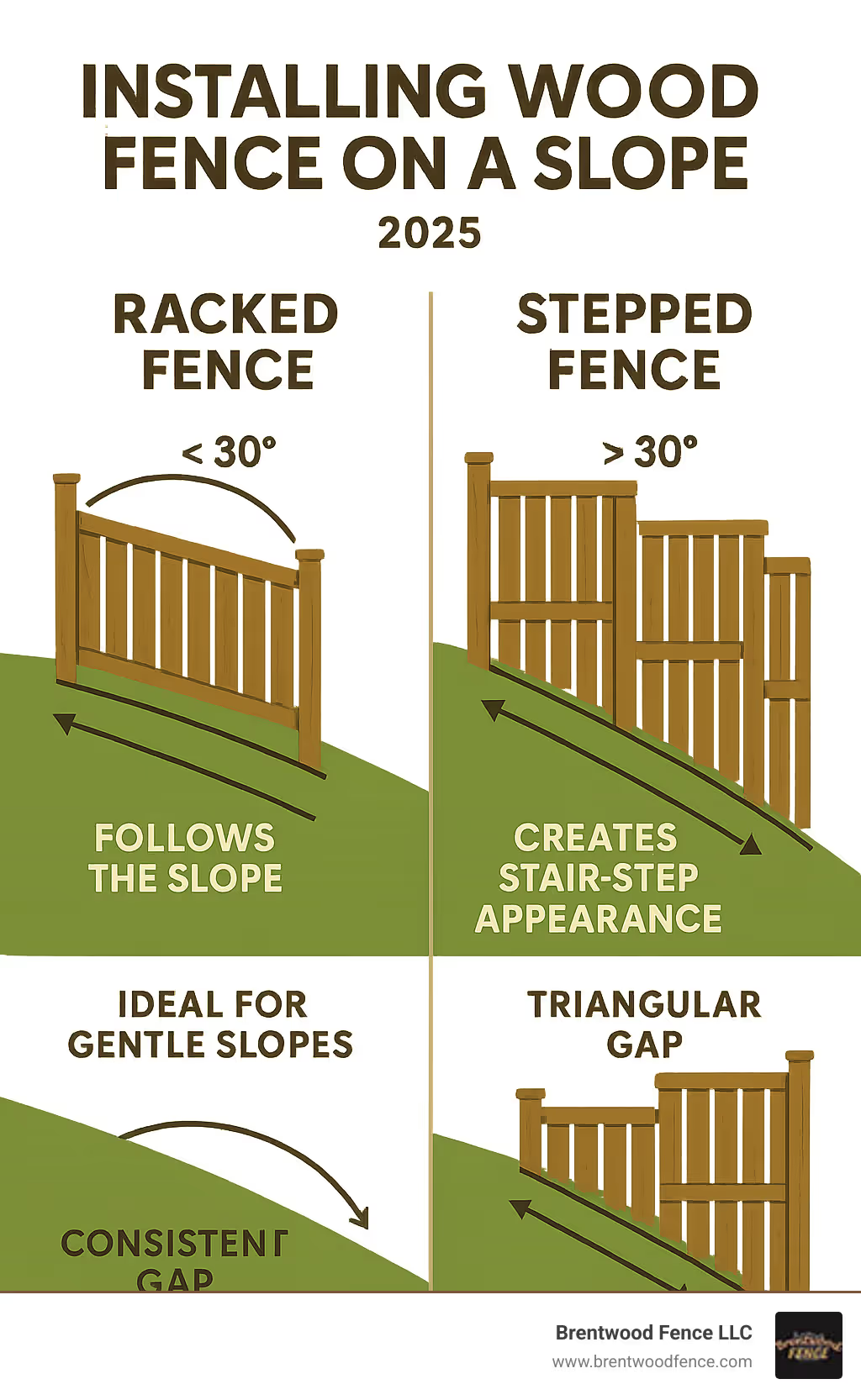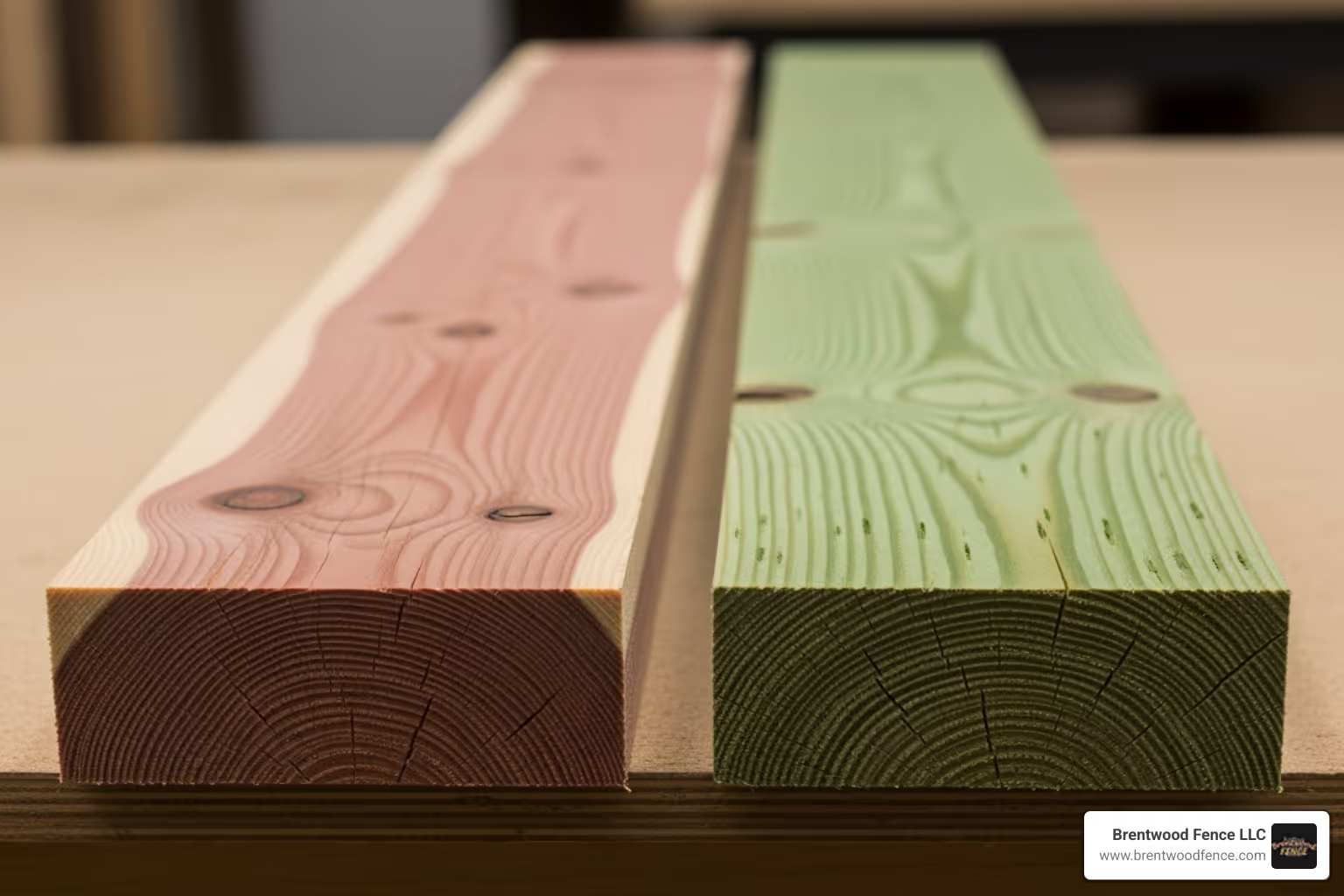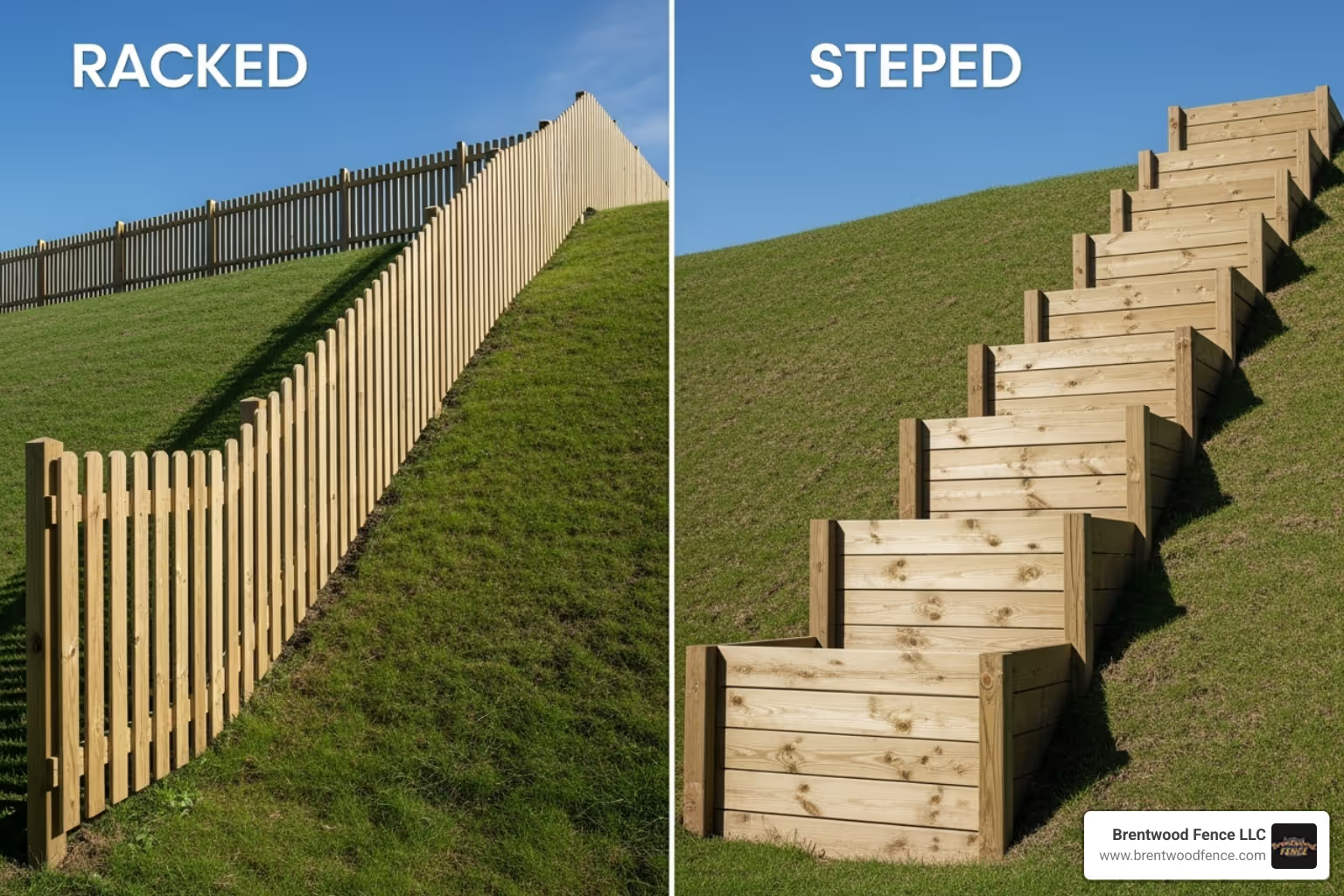Blog Content
16
Sep
2025

Installing wood fence on a slope requires specialized techniques and careful planning to achieve both security and visual appeal. Unlike flat terrain installations, sloped properties demand specific approaches to maintain structural integrity while creating an attractive boundary.
Quick Guide to Sloped Fence Installation:
Many homeowners find that their dream fence project becomes more complex when dealing with elevation changes. As one frustrated homeowner noted in a recent forum discussion: "I hired one of the largest and highest rated fence builders in my area... We have a fairly steep hill and other than the fence company requiring me to clear a path three feet wide through the woods, they said it would not be a problem."
The reality is that slope installations require expertise beyond standard fencing knowledge. Poor planning often results in unsightly gaps, structural instability, or drainage issues that compromise both function and appearance.
Professional wood fence installation becomes especially valuable on sloped terrain. The complexity of maintaining proper post alignment, managing water drainage, and achieving consistent aesthetics makes this a project where experience truly matters.

Installing wood fence on a slope terms at a glance:
Proper planning is the most critical step when installing wood fence on a slope. We've seen many DIY projects go wrong due to a lack of preparation. A thorough plan, created before any tools are touched, is the key to avoiding structural nightmares.
Every slope is unique. We walk your entire property line, noting every dip, rise, and quirky spot. During this assessment, we check for drainage patterns, erosion, and rocky areas that might complicate digging.
We also measure the rise over run to get precise slope calculations. This involves placing stakes at key points and using a level line to measure how much your land rises (or falls) over a given horizontal distance. These measurements directly determine whether we'll use a racked method for gentler slopes or a stepped approach for steeper terrain.
Nobody wants a surprise visit from the city inspector. We always verify boundaries and pull any required permits before breaking ground. We recommend setting your fence posts about 4 inches inside your actual property line to prevent concrete footings from accidentally encroaching on your neighbor's land.
Safety comes first, which means calling Dig Safe before any digging begins. Hitting a gas or electric line can turn your project into a disaster. We also check local building codes and HOA regulations for height restrictions, setback requirements, and material guidelines.
What's your fence supposed to accomplish? Privacy, pet containment, or pure curb appeal? The purpose drives every design decision. A privacy fence has different requirements than a decorative one. If you're containing pets, we pay special attention to gap management, which is especially important with stepped installations.
Gate placement deserves extra thought on sloped properties. We look for relatively flat spots where gates can swing freely without dragging on the ground.
For more insights into professional installation principles, check out our Professional Fence Installation 101 guide.

When you're installing wood fence on a slope, material choice is critical. Slopes create unique challenges with water runoff and soil stability.
Beyond the wood, supporting materials are key. Metal posts can provide superior stability in shifting slope conditions. We always use concrete footings for extra stability against gravity. Gravel in every post hole ensures proper drainage, and we use galvanized fasteners to prevent rust.
For more specific guidance on wood options in our region, see our Best Privacy Fence Options NH, MA, ME recommendations.
The choice between racked or stepped installation is fundamental to any sloped fence project.
Racked installations work beautifully on gentle slopes (under 30 degrees), flowing with your landscape's natural contours.
Stepped installations tackle steep grades. Each panel stays level while the overall fence climbs the slope in distinct steps, providing stability on challenging terrain.
Your aesthetic preference also matters. Some homeowners love the flowing lines of a racked fence, while others prefer the clean look of stepped panels. Both create beautiful, functional fences when installed properly.
When we approach installing wood fence on a slope, the decision between the racked and stepped methods is fundamental. It's about finding the perfect balance between aesthetics, functionality, and the natural contours of your land.

The steepness of the slope is our primary guide. As mentioned, a racked fence is often recommended when your yard’s slope is at 30 degrees or less, offering a uniform appearance that follows the ground. For steeper slopes, where the angle is more than 30 degrees, stepping may offer a cleaner, more functional look. Both methods, when executed by professionals, ensure robust structural stability.
The racked method is our go-to solution for properties with gentle inclines. Imagine a perfectly custom suit for your landscape – that's what a racked fence delivers.
How It Works: In a racked installation, the fence panels or rails are angled to match the slope, allowing the fence to follow the natural contour of the land. The individual pickets or boards remain plumb (perfectly vertical), while the top and bottom rails run parallel to the ground's gradient. This creates a seamless, flowing line that looks as if the fence was custom-built for your specific slope – because, in a way, it is!
Ideal for Gentle Slopes: This technique works beautifully for slopes that are 30 degrees or less. For these gentler gradients, racking maintains a uniform appearance and a consistent gap between the bottom of the fence and the ground. This prevents unsightly gaps that could allow pets to escape or small children to wander through.
Aesthetic Appeal: The primary advantage of a racked fence is its smooth, continuous look. It integrates beautifully with the landscape, creating a visually pleasing effect that complements the natural flow of your property. There are no abrupt changes in height, just a graceful descent or ascent. While this method requires specific rackable fence systems or careful angled cuts for the rails, the result is a truly neat solution.

When we face a steeper slope, the stepped method becomes our most effective strategy. Think of it as building a sturdy staircase for your fence, section by section.
How It Works: Unlike racking, the stepped method involves installing fence panels in distinct, level sections, similar to a series of steps. Each panel is installed horizontally, and then the next panel is dropped down to the next level of the slope. This creates a stair-step appearance, with each panel remaining level and plumb.
Ideal for Steeper Slopes: Stepped installations are ideal for slopes that are more than 30 degrees, where racking would become impractical or would result in panels that are too severely angled. This method offers excellent stability for significant elevation changes.
Addressing Triangular Gaps: One characteristic of stepped fences is the creation of triangular gaps underneath each panel where the horizontal bottom rail meets the sloping ground. These gaps are a common concern for homeowners, particularly regarding pet safety and child security. We have several professional solutions to address these:

While the stepped method might create a less continuous appearance than racking, its stability and effectiveness on steep terrain make it an invaluable technique for installing wood fence on a slope.
When we're installing wood fence on a slope, the real test is how well it stands up to years of weather and ground shifts. The foundation work and finishing touches are what transform a good fence into a great one that lasts.
Fence posts are the unsung heroes of your installation, and on a slope, they're working overtime against gravity.
Fence Repair Company NH, MA, ME
A well-installed fence is just the beginning. The finishing touches protect your investment and integrate it into your landscape.
We've helped countless homeowners steer the challenges of installing wood fence on a slope. Here are the answers to the most common questions we hear.
Yes, sloped installations typically cost more than those on flat ground. The increased cost is due to:
While the upfront cost is higher, a professional installation protects your investment by preventing costly structural and aesthetic issues down the road.
Cost of Wood Fence Installation NH, MA, ME
While there's no single rule, the practical limit for traditional fencing is around 45 degrees.
For extreme slopes, integrating the fence with retaining walls or terracing is often the best solution. A professional assessment is crucial to determine the right approach for your property.
Those triangular gaps are a common concern, especially for pet and child safety. We have several proven solutions:
Installing a wood fence on a slope is a complex project where professional expertise is invaluable. While understanding the racked and stepped methods is helpful, flawless execution requires experience in managing gravity, drainage, and proper post alignment to avoid common pitfalls like wobbly posts or unsightly gaps.
A professionally installed fence on a slope provides stability and safety that lasts for decades, preventing costly repairs and protecting your investment. At Brentwood Fence LLC, we have years of experience tackling New England's challenging terrain. We understand the local soil conditions and weather patterns in New Hampshire, Massachusetts, and Maine, from the hills of Exeter NH to the varied landscapes across the region.
Your sloped property isn't a limitation; it's an opportunity to create something truly special. The long-term value of getting it right the first time far outweighs any initial investment. Don't let the challenge of a slope stop you from getting the fence you want.
Contact us for professional Wood Fencing Installation Services
Copyright 2022 Brentwood Fence | All Rights Reserved | Sitemap | Website by Plumb Development a Digital Marketing Agency